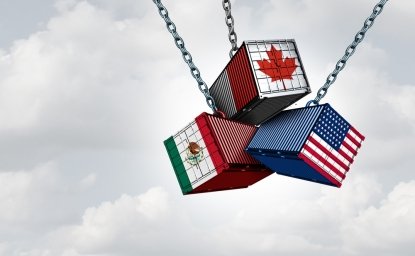One of Donald Trump’s central trade policy objectives is bringing back production and jobs to the United States. To achieve this, Small and Medium-sized Enterprises (SMEs) play a crucial role in producing intermediate goods and enhancing regional and global supply chains. “America First” is not “America Alone”.
This text will explore:
- The American value-added trade relationships with key trading partners
- the co-production between some partners vs. the unbalanced trade relationships with other countries
- How SMEs and our regional allies fit into the “winning formula” for the “American Golden Age”
When evaluating international trade volumes and understanding the complexity of the production network, it becomes evident that further integration and increasing intraregional trade[1] are crucial to ensuring global competitiveness and increased capacity to address geopolitical challenges.
The US and its USMCA partners' total trade of goods and services exceeds $1.8 trillion, with a growth of over 50% between 2021 and 2023 (USTR, 2024). Today, the region goes beyond simple trade transactions to a co-production system. This results in a shared value model, contrasting with trade relationships involving economies like China or Vietnam, where integration is lower.
Table 1. US Export Value Added – Origins and Destinations

The most updated data set by the OECD (2023) presents information up to 2020. While many things have changed recently, this data allows us to analyze long-time trade relationships and trends. The first table shows the share of foreign and domestic value added[2] in US gross exports, expressed as a percentage of total exports.
Higher domestic value added simply means that there is a process of production and value generation in the US over imports from a particular country. Canada and Mexico contribute an additional 2.6% and 2.8% of domestic value added to US exports, respectively, while economies such as China (1.8%) and Vietnam (0.4%) show notably lower percentages. This reinforces the notion that Mexico and Canada not only export finished goods but also serve as key players in the US production chains, providing essential inputs that go over a robust value-add process in the US to be later exported to other markets, yielding higher returns to the US.
Table 2. Trade Partners' Share in the Value Added of US Exports

On the flip side, the second table shows the share of US value added in exports from various countries and the level of domestic value-added built over products imported from the US. The result is crystal clear: The trade relationship between the US, Mexico, and Canada is not limited to the exchange of finished goods but operates under a shared manufacturing model in which inputs cross borders multiple times before becoming final products—a defining characteristic of the USMCA.
Mexico and Canada’s exports have 11.3% and 12.7% of value-added originated in the US, respectively. In comparison, other countries such as China (2.7%) have a much smaller contribution. Additionally, when measuring each country’s domestic value added to US imports, Canada added 4.5% and Mexico 3.1%, while Germany (0.5%), China (0.8%), and Vietnam (0.4%), show substantially lower levels.
Mexico has built, over time, a productive integration with strategic industries such as automotive, electronics, and manufacturing, which rely on a steady flow of intermediate goods. In contrast, countries like China and Vietnam have a more independent trade structure that is less tied to US production, suggesting that their trade relationships rely more on finished goods than shared production processes. This should be fundamental when drafting future trade policy and its direct implications for the US productive system. Not every trade relationship is the same.
Graph 1. US Trade Deficit / US Exports with Selected Countries

It is possible to evaluate the US opportunity cost of its trade relations based on their exports and trade balances. In 2023, the US recorded trade deficits with Canada and Mexico of -$64,262.70 million and -$152,473.5 million, respectively. However, when analyzing these deficits in relation to US exports to these countries, they represent -17.10% for Canada and -50.80% for Mexico. In contrast, trade with countries like China (-206.40%), Ireland (-526.10%), and Vietnam (-966.90%) shows disproportionate deficits compared to the US exports sent to them. These figures highlight a heavy reliance on imports, creating a structural challenge for the US economy.
We’ve discussed the relevance of strong interconnectedness through multi-exchanges amongst our economies. SMEs are key players in producing intermediate goods and specialized products that enhance the competitiveness of shared value chains in North America. Also, it is essential to consider the following: “Across OECD countries, SMEs represent around 99% of all firms, are a main source of employment, and generate 50% to 60% of value added on average. Moreover, SMEs are vital for nurturing local communities and driving economies’ and societies’ major transitions.” OECD, 2024.
Unlike large corporations that dominate total export volume, SMEs make up 97% of all US exporters and are critical players in supply chains. Many of these businesses thrive within the USMCA framework, where Mexico and Canada have become their top export destinations. (ITA, 2022)

Source: ITA US Exporter Database
In 2022, more than 90,000 US SMEs exported $83 billion to Canada, while nearly 50,000 SMEs sent $110 billion to Mexico. These figures represent significant growth compared to previous years, reflecting the strong demand for US products in both markets and the importance of regional productive integration while closing the argument that the “backbone” of the US productive system is cemented on its regional integration. (USTR, 2024)
While protectionist policies may yield immediate benefits for specific sectors, maintaining an open and fair trade and collaboration with its regional allies is key to long-term success. Co-production within North America is key to stable economic growth and rebuilding the US industrial base. To thrive in a golden age, we must remain united as a block.
[1] International trade is increasingly concentrated around three major regions: Europe, East Asia, and North America. Together, they account for 85% of global trade. Yet, Europe and East Asia are much more regionally integrated when it comes to trade, than is North America. For example, 70% of European exports stay within Europe, and over 50% of East Asian exports remain within the region. North America, by contrast, only retains just over 30% of its exports within the region (The World Bank Global Indicators, 2023). This is largely due to our heavy reliance on East Asian imports, particularly from China.
[2] Value added reflects the value generated by producing goods and services, and is measured as the value of output minus the value of intermediate consumption. Value added also represents the income available for the contributions of labour and capital to the production process.(OECD, 2024)
Authors



Mexico Institute
The Mexico Institute seeks to improve understanding, communication, and cooperation between Mexico and the United States by promoting original research, encouraging public discussion, and proposing policy options for enhancing the bilateral relationship. A binational Advisory Board, chaired by Luis Téllez and Earl Anthony Wayne, oversees the work of the Mexico Institute. Read more







